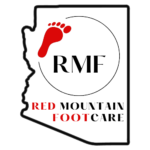How to Treat Sore Feet After Hiking
Outdoor enthusiasts say any hike is a good hike, even though any hike usually ends in sore feet.
This is usually accepted as one of the sacrifices required in order to access great natural scenery and get exercise.
But how and why your feet hurt are important, and how you treat them can also play a role in whether they keep on hurting or the pain goes away.
Red Mountain Foot Care is always happy to provide advice and suggestions to help reduce your pain after a hike, and we also will be happy to take a look afterward, especially if the pain persists or even gets worse.
Sometimes a solution is as simple as making sure your boots or socks all fit properly, since if they’re too big or too small, they can cause pain or blisters. Or adjusting your load helps – an overly heavy backpack can put pressure on your back and shoulders, which can eventually cause pain in your feet.
There are also a variety of exercises that can be done after a hike, or even on a break during a longer hike. This can give your feet a rest and help you continue your journey.
How to Reduce Foot Pain:
-
Prepare For an Extended Adventure
- This goes back to having the right socks and the right footwear for the conditions you’re going to be hiking in. If it’s fairly flat, you might be fine with shoes. If it’s steep and rocky, you’ll need something that can adapt easily and support your ankles. If it’s a long hike, make sure you have something durable with a cushion for your feet. It also wouldn’t hurt to schedule a check-out from a podiatrist, who can indicate if there are any existing conditions that can be aggravated by hiking such as bone problems, nerve damage, or muscle damage.
-
Take Time to Adjust
- A common mistake many hikers make is to “suck it up” if things start hurting right away, such as getting a rock in your boot. If you don’t pause, it can work its way in and start rubbing your feet, causing increasing pain over time. Taking a few minutes early on can avoid having to treat sore feet later.
-
Give Them a Break
- When you stop for a meal or to catch your breath, consider removing your boots and your socks to let your feet breathe. If there’s a stream or lake nearby, it’s even better. Go ahead and soak them for a few minutes. Even if there’s no nearby body of water, you can still use lotion to lubricate them.
-
Rub & Exercise Your Feet
- Yes, hiking does count as exercise, but it generally requires the same motion from the feet. If you want to strengthen parts of your feet such as the tendons and muscles, consider regular exercises such as squeezing the ball of your feet while raising the heel, inverting your ankle, and flexing your foot like you would a car gas pedal.
-
Keep Hydrated
- This is generally good advice for hiking, especially with regards to helping your muscles and not getting overheated. Adequate fluid levels can increase blood flow to the feet.
With so many hiking opportunities in this area, there’s plenty to see and do. Red Mountain Footcare is ready to treat sore feet to help you go the distance.
